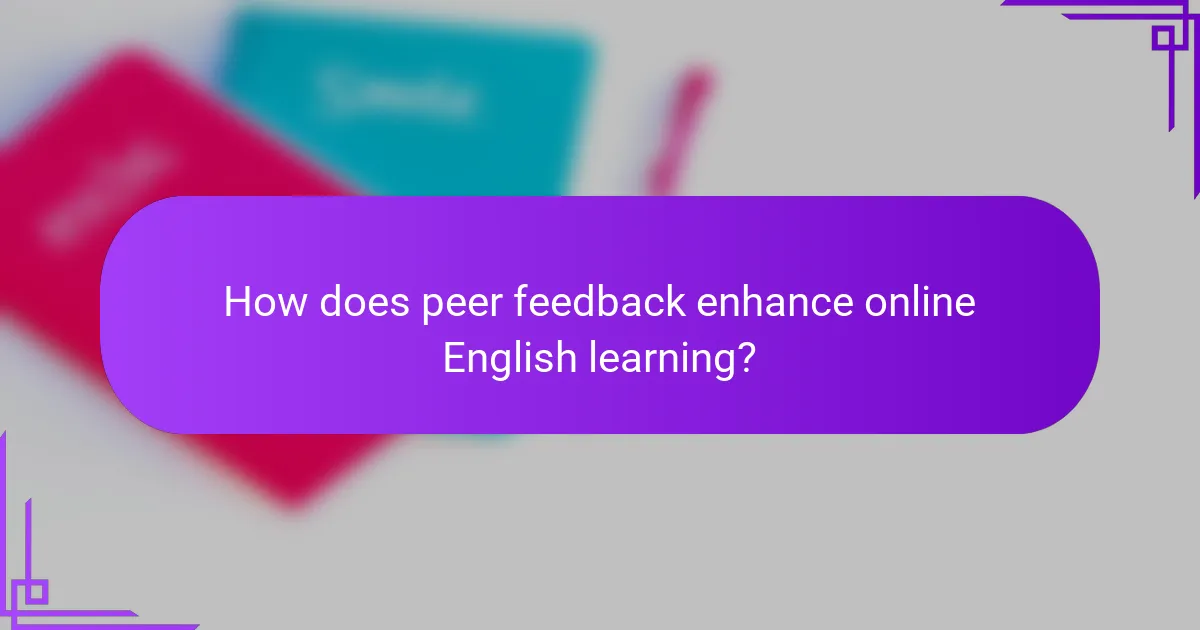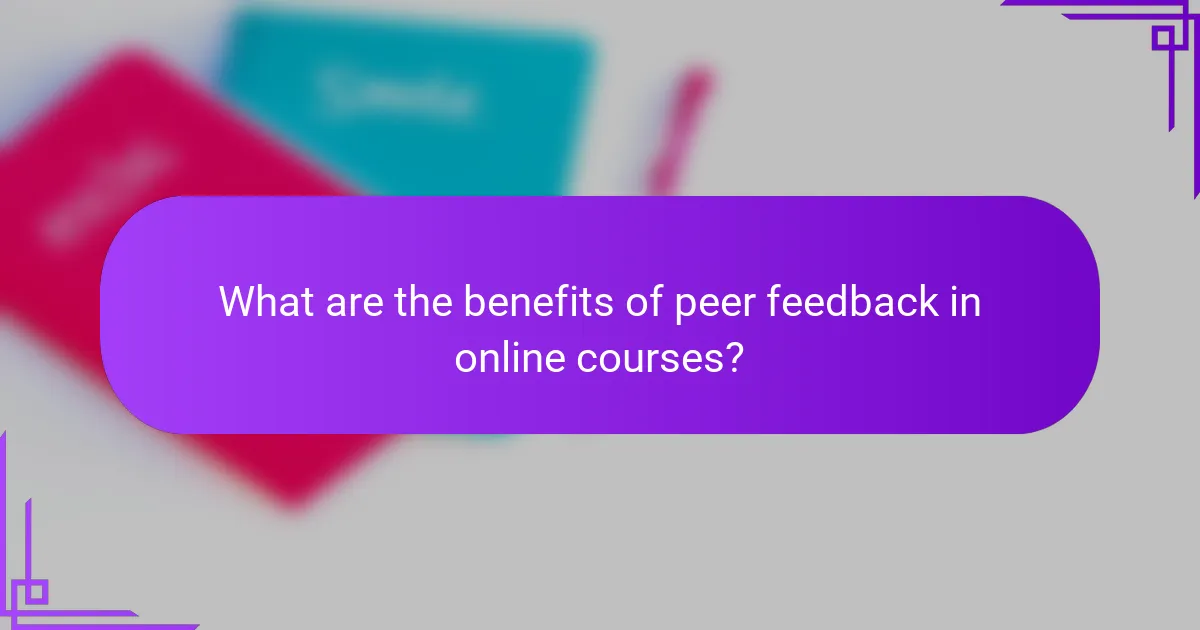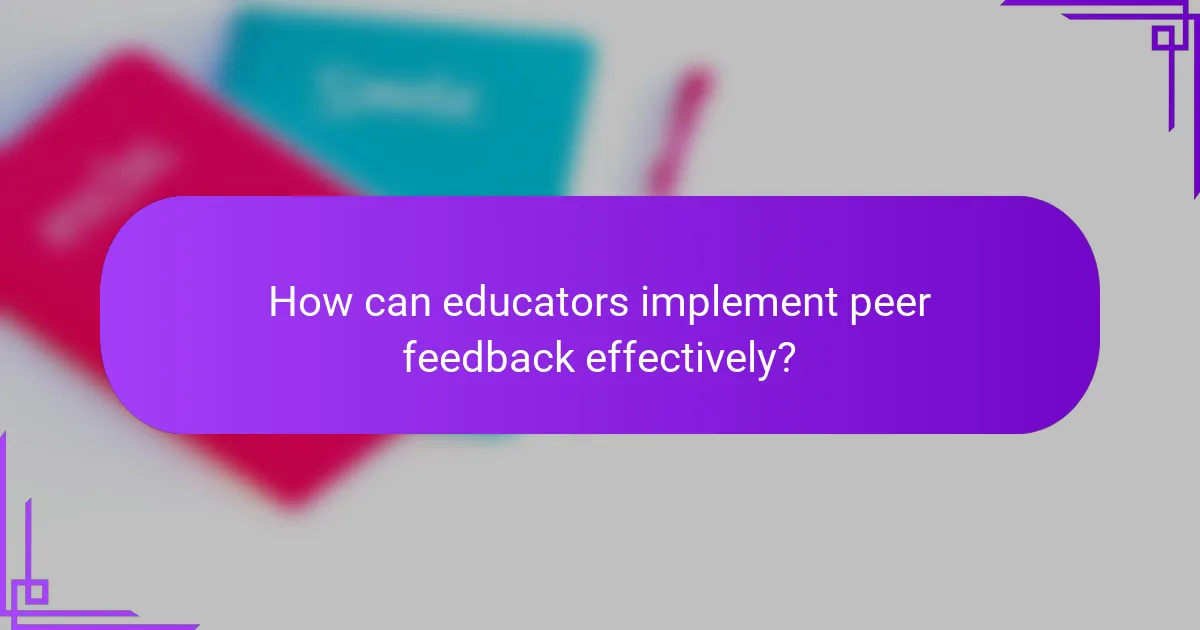Peer feedback plays a crucial role in online English learning by offering students varied perspectives on their language skills, ultimately leading to enhanced understanding and proficiency. This collaborative approach not only fosters a supportive learning environment but also encourages active participation, allowing learners to identify their strengths and areas for improvement.

How does peer feedback enhance online English learning?
Peer feedback enhances online English learning by providing learners with diverse perspectives on their language use, which can lead to improved understanding and skills. Engaging with peers allows students to identify strengths and weaknesses in their language abilities, fostering a more interactive and supportive learning environment.
Improves language skills
Peer feedback directly contributes to the improvement of language skills by allowing learners to practice and refine their writing and speaking abilities. When students review each other’s work, they can spot grammatical errors, suggest vocabulary enhancements, and provide insights into more effective communication strategies.
For instance, a student might receive feedback on their essay structure or clarity, which can lead to significant improvements in future assignments. Regular peer evaluations can help learners develop a critical eye for language, making them more adept at self-correction.
Boosts learner confidence
Receiving constructive feedback from peers can significantly boost learner confidence in their language abilities. Positive reinforcement from fellow students helps individuals recognize their progress and encourages them to take risks in their language use.
For example, when a student receives praise for their pronunciation during a speaking exercise, they are more likely to engage in future discussions. This cycle of feedback and encouragement fosters a supportive atmosphere where learners feel valued and motivated to improve.
Encourages collaborative learning
Peer feedback promotes collaborative learning by creating opportunities for students to work together and share knowledge. When learners engage in discussions about their feedback, they can explore different viewpoints and strategies, enriching their overall learning experience.
In practice, this might involve group projects where students critique each other’s contributions, leading to a deeper understanding of the subject matter. Collaborative feedback sessions can also help build a sense of community among learners, making online English learning more enjoyable and effective.

What are the benefits of peer feedback in online courses?
Peer feedback in online courses enhances learning by allowing students to share insights and critiques, which can lead to improved understanding and performance. This collaborative approach not only builds community but also encourages active participation among learners.
Increases engagement
Peer feedback significantly boosts student engagement by creating a sense of accountability and involvement. When learners know their peers will review their work, they are more likely to invest time and effort into their assignments.
To maximize engagement, instructors can implement structured peer review processes, such as setting clear deadlines and providing guidelines for constructive feedback. This structure helps maintain focus and encourages students to participate actively.
Provides diverse perspectives
Receiving feedback from peers exposes students to a variety of viewpoints, enriching their understanding of the subject matter. Different backgrounds and experiences can lead to unique insights that enhance critical analysis and creativity.
Encouraging students to engage with diverse peers can be facilitated through group projects or discussion forums. This diversity not only broadens perspectives but also fosters a more inclusive learning environment.
Fosters critical thinking
Peer feedback cultivates critical thinking by prompting students to evaluate their own work and that of others. Analyzing feedback helps learners develop reasoning skills and encourages them to reflect on their thought processes.
To strengthen critical thinking, educators should guide students on how to give and receive feedback effectively. This can include training on how to ask probing questions and how to articulate constructive criticism, ultimately enhancing their analytical abilities.

How can educators implement peer feedback effectively?
Educators can implement peer feedback effectively by establishing clear guidelines, leveraging technology, and scheduling regular feedback sessions. These strategies enhance the quality of feedback and ensure that students engage meaningfully with their peers’ work.
Structured feedback guidelines
Providing structured feedback guidelines helps students understand what to focus on when reviewing their peers’ work. Educators can create rubrics that outline specific criteria, such as content clarity, grammar, and engagement. This approach not only standardizes feedback but also makes it easier for students to give constructive criticism.
Encourage students to use positive language and to balance their critiques with commendations. For example, they might highlight strong points before suggesting areas for improvement. This method fosters a supportive learning environment and motivates students to participate actively.
Utilizing technology platforms
Technology platforms can facilitate peer feedback by offering tools that streamline the process. Online learning management systems (LMS) like Google Classroom or Moodle allow students to submit work and receive feedback in a centralized location. Features such as comment threads and peer review options enhance collaboration.
Additionally, using dedicated peer feedback tools, such as Peergrade or FeedbackFruits, can provide structured environments for students to engage with each other’s work. These platforms often include templates and prompts that guide students in providing meaningful feedback.
Regular feedback sessions
Scheduling regular feedback sessions encourages consistent engagement and improvement among students. These sessions can be weekly or bi-weekly, allowing students to reflect on previous feedback and apply it to new assignments. This iterative process promotes deeper learning and skill development.
During feedback sessions, educators should facilitate discussions that allow students to ask questions and clarify points. This interaction not only reinforces the feedback but also builds a sense of community among learners, making them more comfortable sharing their thoughts and insights.

What challenges exist with peer feedback in online learning?
Peer feedback in online learning faces several challenges that can hinder its effectiveness. Key issues include the quality of feedback provided, student reluctance to engage, and time constraints that limit thorough evaluations.
Quality of feedback
The quality of feedback can vary significantly among peers, often leading to inconsistent and unhelpful critiques. Some students may lack the skills to provide constructive comments, which can result in vague or overly critical feedback that does not aid improvement.
To enhance feedback quality, educators can provide guidelines or rubrics that outline specific criteria for effective peer reviews. This structured approach helps students focus on key aspects of the work, such as clarity, coherence, and argument strength.
Student reluctance
Many students feel hesitant to give or receive feedback from peers due to fear of judgment or a lack of confidence in their own abilities. This reluctance can diminish participation and limit the potential benefits of peer feedback.
To combat this issue, creating a supportive environment is crucial. Encouraging open discussions about the value of feedback and normalizing the learning process can help students feel more comfortable engaging in peer reviews.
Time constraints
Time constraints often pose a significant challenge in online learning environments, where students may juggle multiple commitments. Limited time can lead to rushed feedback, which may lack depth and thoroughness.
To address this, educators can allocate specific time slots for peer feedback sessions and encourage students to manage their schedules effectively. Setting clear deadlines and providing reminders can also help ensure that feedback is given in a timely manner, allowing for meaningful exchanges.

What frameworks support effective peer feedback?
Effective peer feedback in online English learning is supported by structured frameworks that guide learners in providing constructive and meaningful critiques. These frameworks often include specific models and assessment criteria that enhance the feedback process, ensuring that it is both relevant and actionable.
Feedback models
Feedback models provide a systematic approach for learners to evaluate each other’s work. Common models include the “Sandwich Model,” which emphasizes starting with positive comments, followed by constructive criticism, and concluding with encouragement. This method helps maintain a supportive atmosphere while addressing areas for improvement.
Another effective model is the “Peer Review Checklist,” which outlines specific aspects to assess, such as clarity, coherence, and grammar. By using such checklists, learners can focus their feedback on key elements, making it easier to provide targeted suggestions.
Assessment criteria
Assessment criteria are essential for guiding peer feedback, as they define what aspects of a piece of work should be evaluated. Common criteria in online English learning include organization, language use, and engagement with the topic. Clearly defined criteria help learners understand expectations and provide more focused feedback.
When creating assessment criteria, it’s beneficial to involve students in the process. This encourages ownership and ensures that the criteria are relevant to their learning objectives. A simple rubric can be developed, rating each criterion on a scale from 1 to 5, allowing for a quick overview of strengths and weaknesses.

What are the emerging trends in peer feedback for English learning?
Emerging trends in peer feedback for English learning emphasize collaborative learning, digital platforms, and personalized feedback mechanisms. These trends enhance engagement and provide learners with diverse perspectives on their language skills.
Increased Use of Technology
The integration of technology in peer feedback processes is transforming English learning. Online platforms and applications facilitate real-time feedback, allowing learners to share their work and receive comments instantly. Tools like Google Docs and various language learning apps enable seamless collaboration among peers.
Additionally, video and audio feedback options are becoming popular, as they allow for more nuanced communication. Learners can hear pronunciation tips or see facial expressions, which enriches the feedback experience.
Focus on Collaborative Learning
Collaborative learning is gaining traction in peer feedback, where students work together to improve their language skills. This approach fosters a sense of community and encourages learners to take ownership of their learning process. Group activities, such as peer review sessions, can enhance motivation and accountability.
In practice, setting up structured peer feedback sessions can lead to more effective outcomes. For example, pairing students for specific tasks can help them focus on particular aspects of language learning, such as grammar or vocabulary usage.
Personalized Feedback Mechanisms
Personalized feedback is becoming increasingly important in peer feedback for English learning. Tailoring feedback to individual needs helps learners address specific challenges and enhances their progress. This can be achieved through targeted questions or prompts that guide peers in providing constructive criticism.
To implement personalized feedback, educators can provide guidelines on effective feedback techniques. Encouraging students to ask clarifying questions or suggest improvements can lead to richer discussions and deeper understanding.


